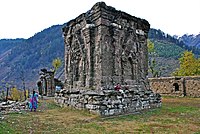
Sati, also known as Dakshayani, is the Hindu goddess of marital felicity and longevity, and is worshipped as an aspect of the mother goddess Shakti. Sati was the first wife of Shiva, the other being Parvati, who was Sati's reincarnation after her death.

The Shakti Pithas or the Shakti Peethas are significant shrines and pilgrimage destinations in Shaktism, the mother goddess denomination in Hinduism. The shrines are dedicated to various forms of Adi Shakti. Various Puranas such as Srimad Devi Bhagavatam state the existence of a varying number of 51, 52, 64 and 108 Shakti Pithas of which 18 are named as Astadasha Maha (major) in medieval Hindu texts.
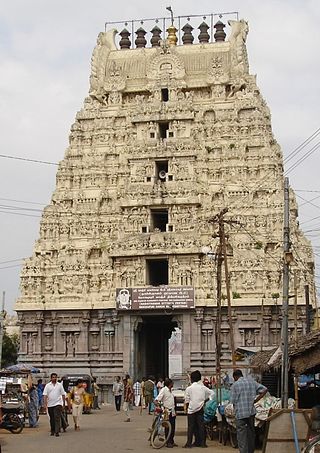
The Kamakshi Amman Temple, also known as Kamakoti Nayaki Kovil, is a Hindu temple dedicated to the goddess Kamakshi, one of the highest aspects of Adi Parashakti, the supreme goddess in Shaktism. The temple is located in the historic city of Kanchipuram, near Chennai, India.

Saptashrungi or Saptashringi is a site of Hindu pilgrimage situated 60 kilometres (37 mi) from Nashik in Indian state of Maharashtra. According to Hindu traditions, the goddess Saptashrungi Nivasini dwells within the seven mountain peaks. It is located in Nanduri, Kalwan taluka, a small village near Nashik in India. The Marathas and some Hindu tribes worship the goddess from a long time and some worship as their kuldaivat. There are 510 steps to climb the gad. Devotees visit this place in large numbers every day. The temple is also known popularly as one of the "three and half Shakti Peethas" of Maharashtra. The temple is also one among the 51 Shakti Peethas located on the Indian subcontinent and is a location where one of Sati's limbs, her right arm is reported to have fallen. Its half shaktipeeth among three and half shaktipeeth of Maharashtra.

Tripura Sundari Temple is a Hindu temple of the Goddess Tripura Sundari, better known locally as Devi Tripureshwari. The temple is situated in the ancient city of Udaipur, about 55 km from Agartala, Tripura and can be reached by train and road from Agartala. It is believed to be one of the holiest Hindu shrines in this part of the country and witnesses the highest number of visitors for a temple in North-East India, after Kamakhya Temple in Assam. The state of Tripura is named after this temple. Popularly known as Matabari, the shrine is set upon a small hillock that resembles the hump of a tortoise (Kurma). This shape called Kurmapṛṣṭhākṛti is considered the holiest possible site for a Shakti temple, hence also bestowing the name of Kurma Pīṭha. The Goddess is served by traditional Brahmin priests.

The Vishalakshi Temple or Vishalakshi Gauri Temple is a Hindu temple dedicated to the goddess Vishalakshi, at Mir Ghat on the banks of the Ganges at Varanasi in Uttar Pradesh, India. It is generally regarded as a Shakti Pitha, the most sacred temples dedicated to the Hindu Divine Mother.

Hinglaj Mata, also known as Hinglaj Devi, Hingula Devi and Nani Mandir, is a Hindu temple in Hinglaj, a town on the Makran coast in the Lasbela district of Balochistan, and is the middle of the Hingol National Park. It is one of the 51 Shakti Peethas in Shaktism denomination of Hinduism. It is one of the three Shakti Peethas in Pakistan, other two being Shivaharkaray and Sharada Peeth. It is a form of Durga or Devi in a mountain cavern on the banks of the Hingol River. Over the last three decades the place has gained increasing popularity and became a unifying point of reference for Pakistan's many Hindu communities. Hinglaj Yatra is the largest Hindu pilgrimage in Pakistan. More than 250,000 people take part in the Hinglaj Yathra during the spring.

Hinglaj is an important Hindu pilgrimage place in Balochistan, Pakistan and Kuldevi of many Rajput, Charan, Rajpurohits and other Hindu Communities of India. It is situated in Balochistan province about 250 km west-northwest of Karachi. The Shri Hinglaj Mata mandir which is the largest Hindu pilgrimage centre in Pakistan is located here.

The Shree Bajreshwari Mata Mandir also known as Kangra Devi Mandir is one of the 51 Shakti Pithas dedicated to the goddess Vajreshvari, a form of Goddess Durga located in the town Kangra in the Northern Indian state of Himachal Pradesh.

Chandranath Temple, located on top of the Chandranath Hill, is a famous Shakti Peeth located near Chittagong in Bangladesh where, as per Hindu sacred texts, the right arm of Deiti Sati fell. Chandranath Temple is a pilgrimage site for Hindus. Its height about 1,020 feet (310 m) above sea level.

Bhabanipur is a Hindu temple complex in northwestern Bangladesh located about 33 kilometres (21 mi) from Bogra. It is located in Sherpur Upazila of Bogra District, Rajshahi Division. It is one of the Shakti Pithas of the Indian subcontinent.
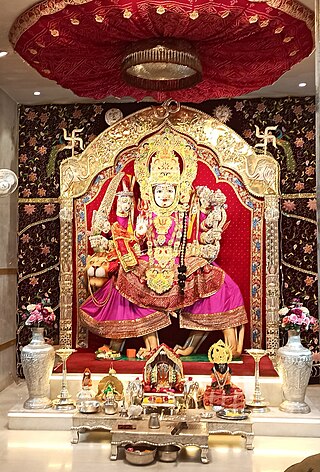
Yogamaya, also venerated as Vindhyavasini, Mahamaya, and Ekanamsha, is a Hindu goddess.
Shri Shri Mahalakshmi Bhairabi Griba Maha Peetha is one of the Shakti Peeths, at Joinpur village, Dakshin Surma, near Gotatikar, 3 km south-east of Sylhet town, Bangladesh. The Hindu Goddess Sati's neck fell here. The Goddess is worshipped as Mahalakshmi and the Bhairav form is Sambaranand.
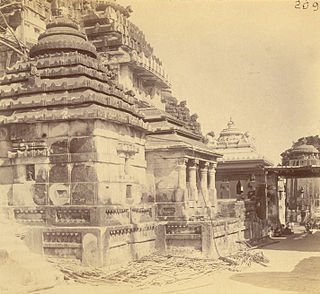
The Vimala Temple or Bimala Temple is a Hindu temple dedicated to goddess Vimala or Bimala (ବିମଳା), located within the Jagannath Temple complex in Puri in the Indian state of Odisha. It is generally regarded as a Shakti Pitha, among the holiest temples dedicated to the Hindu Goddess.
In religion and spirituality, a pilgrimage is a very long journey or search of great moral significance. Sometimes, it is a journey to a sacred area or shrine of importance to innate faith. Members of every major religion participate in pilgrimages. A person who makes such a journey is called a pilgrim.
Sugandha Shaktipeeth, a temple of the Goddess Sunanda, is located in the village of Shikarpur, 10 miles north of Barisal, in Bangladesh. This Hindu temple is one of the Shakti Peethas.

Dakṣayajña is an important event in Hindu mythology that is narrated in various Hindu scriptures. It refers to a yajna (ritual-sacrifice) organised by Daksha, where his daughter, Sati, immolates herself. The wrath of the god Shiva, Sati's husband, thereafter destroys the sacrificial ceremony. The tale is also called Daksha-Yajna-Nasha. The legend forms the liturgical basis of the establishment of the Shakti Pithas, the temples of Mahadevi, the supreme deity of Shaktism. It also becomes a prelude to the legend of Parvati, Sati's reincarnation, who later marries Shiva.
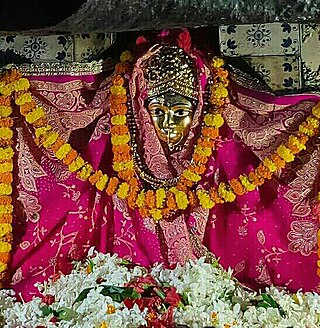
Maa Tara Chandi Temple is a Hindu temple dedicated to Maa Shakti or Maa Durga, located in Sasaram, Bihar, India. It is one of the 51 Shakti Peetha.
Three and a half Shakti Peethas are reported in Maharashtra.

















